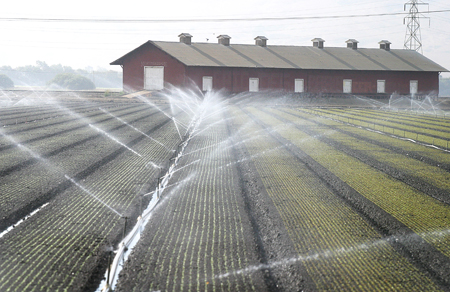
Development credits bought from farmers allows developers to
build on other ag land
As Santa Clara County cities develop outward and more prime
agricultural land is converted to urban use, preserving what’s left
will be key to the agricultural heritage in the region.
Development credits bought from farmers allows developers to build on other ag land
As Santa Clara County cities develop outward and more prime agricultural land is converted to urban use, preserving what’s left will be key to the agricultural heritage in the region.
“We haven’t had much experience with this in Santa Clara County,” said Neelima Palacherla, the executive director of Santa Clara’s Local Agency Formation Commission.
LAFCO is currently working with city governments, nonprofit conservation groups and other agencies to develop an agricultural mitigation policy that will be used on applications that come before the agency. LAFCO oversees development applications for land outside of the urban service area for Santa Clara County cities – such as 119-acres of farmland that Westfield Corporation has its sights set on for development of a potentially 1.5 million-square-foot mall.
“Our policies have always stated that we should be guided away from development outside of the urban area. We should use up existing lands,” Palacherla said. “If this can’t be done, then some kind of mitigation should be provided.”
The agricultural mitigation policy is likely to effect areas around Gilroy and Coyote Valley, as the build out in Coyote Valley begins in the next several years, according to conservation groups.
“There is no ag land in San Jose to really mitigate for,” said Craige Edgerton, executive director of the Silicon Valley Land Conservancy. “Morgan Hill and San Jose already have a green lines around them that they are not going to expand past.”
The City of Gilroy has its own agricultural mitigation policy to deal with development proposals within its urban service area – a border that is set based on its General Plan’s 20-year boundary. Gilroy adopted its policy in May 2004, the first city in Santa Clara County to adopt agricultural mitigation guidelines.
Gilroy’s policy is similar to the policy that is being drafter by LAFCO for approval this fall.
The city’s policy requires proposals to develop prime agricultural lands to preserve an equal amount of agricultural land in Santa Clara County, preferably outside the city’s General Plan boundary, but near Gilroy. LAFCO requires that lands to be preserved must be in Santa Clara County. Neither Gilroy nor LAFCO have used their policies yet, according to Edgerton.
Developers who want to convert agricultural areas to urban uses have three options.
· They can purchase an equal amount of land and transfer ownership of the land to a conservation group such as Santa Clara Valley’s Open Space Authority or the Silicon Valley Land Conservancy.
· They can purchase a conservation easement – which allows the current owner to maintain ownership of the land but allows a conservation group to “buy” the development rights on the land,” in effect locking up forever the ability to develop that land.
· The last option is to pay in-lieu fees in which they would pay the cost of purchasing development rights.
“I would say 100 percent of the time, the conservation easement is less than half of what it would cost to buy [the property],” Edgerton said. “Generally, it runs in the neighborhood of 25-40 percent of the purchase price.”
The Silicon Valley Land Conservancy oversees several conservation easements in Santa Clara County, including an agricultural easement purchased in May. The easement on Taylor Ranch, a specialty lettuce farm south of Gilroy, cost $2.1 million for 510 acres. OSA, the California Department of Conservation and the U.S. Natural Resources Conservation Service provided the money for the easement and the Land Conservancy holds the development rights. The ranch abuts another property on which Land Conservancy has a conservation easement, the 480-acre Wang Ranch.
Conservation easements are likely to be the main way developers will choose to mitigate future developments involving ag lands, Edgerton said.
“From a financial stand point, I don’t see many people buying 100 acres and donating it,” he said. “We would love it if they did, but unfortunately we live in the real world.”
One challenge for developers as more agricultural land is used up is finding property owners who are willing to negotiate conservation easements, although Edgerton said there are nearly 6,000 acres of agricultural land around Soap Lake.
“We need willing farmers who want to stay in farming,” Edgerton said. “And who just want some cash to sell the development rights.”









